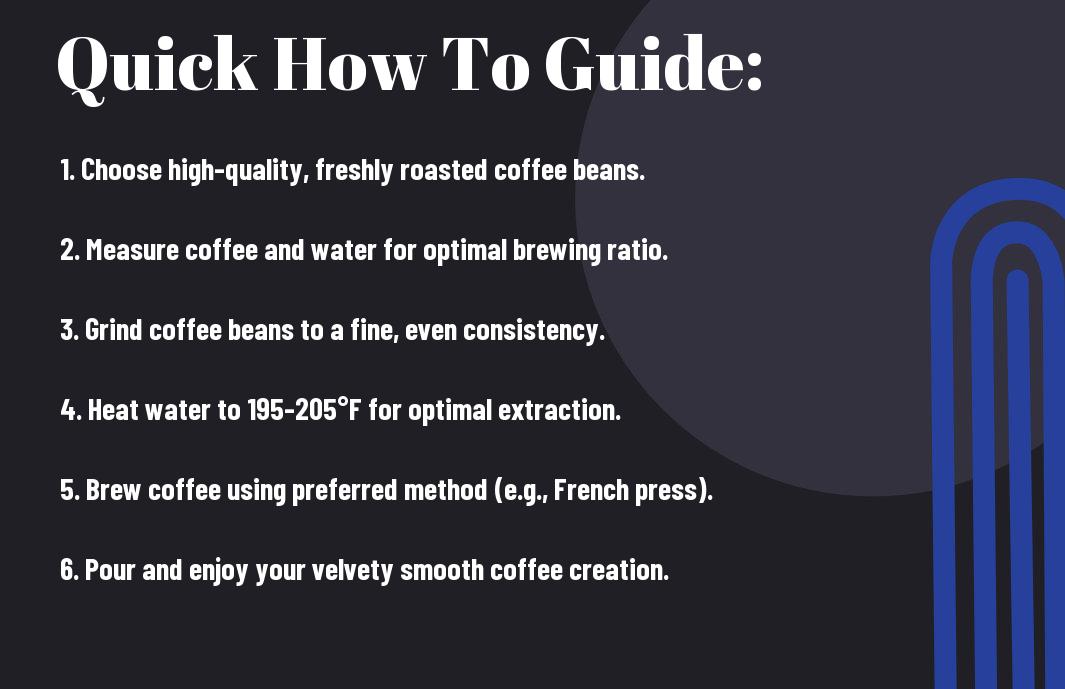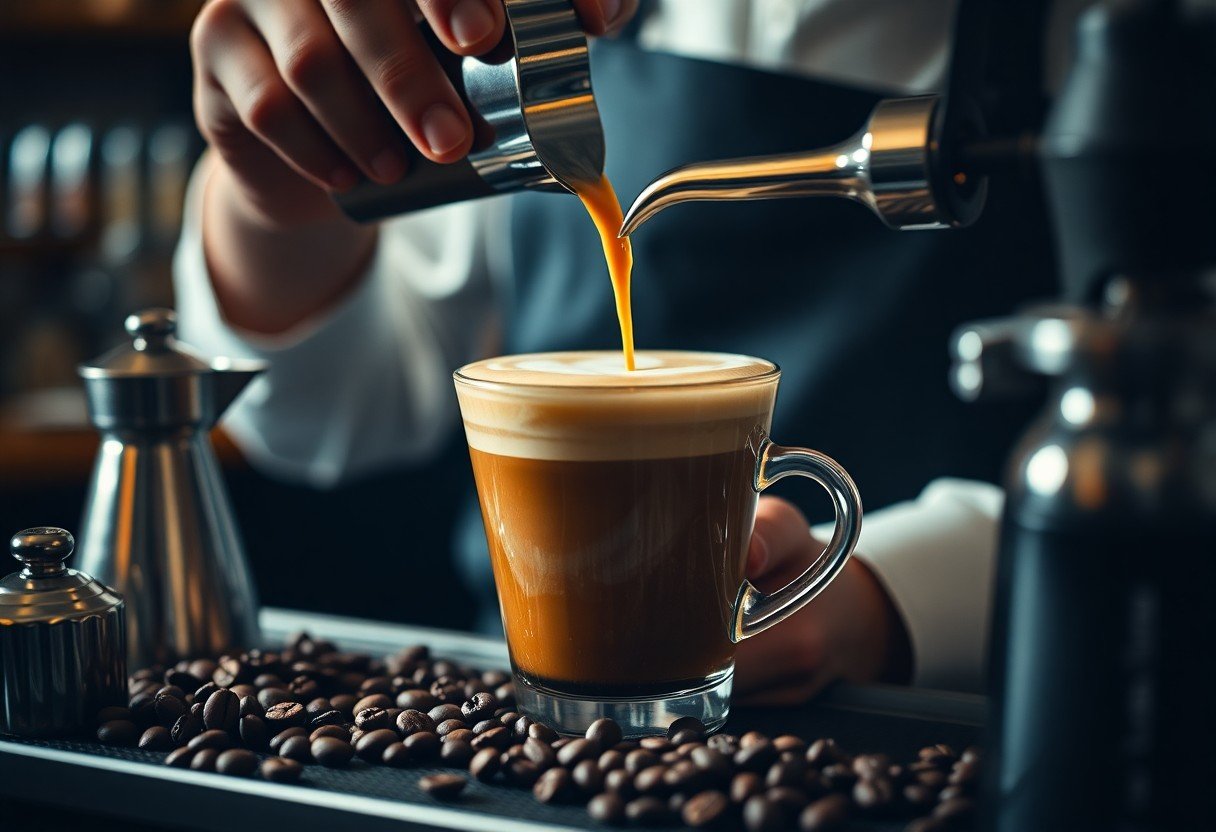Over time, mastering the art of brewing velvety smooth coffee can elevate your daily routine and impress your guests. In this guide, you will discover vital tips and techniques to create barista-quality coffee right in your home. From selecting the right beans to fine-tuning your brewing methods, you’ll learn how to achieve that rich, creamy texture that makes every sip a delight. Get ready to indulge in the perfect cup of coffee with ease!

Understanding the Essentials
Before you launch on your coffee crafting journey, it’s vital to familiarize yourself with the key components that contribute to the perfect brew. Your ultimate aim is to create that velvety smooth cup, and understanding the imperatives will take your coffee experience from ordinary to extraordinary. This involves not only the kind of coffee beans you select but also the quality of water you use, as both elements play a significant role in the overall flavor and texture of your drink.
Choosing Quality Coffee Beans
Assuming you’ve grasped the importance of starting with fresh, high-quality coffee beans, let’s examine deeper into your options. Opt for beans that are freshly roasted, as their flavor can dramatically decline over time. Additionally, consider the specific roast profile that appeals to your palate—light, medium, or dark roasts each bring a unique taste to the table. Sourcing your beans from reputable local roasters can also enhance your coffee-making experience, allowing you to discover unique flavor profiles that might not be present in mass-produced brands.
The Importance of Water Quality
Clearly, water is often overlooked yet plays a vital role in coffee preparation. The quality of water you use can significantly affect the extraction process and ultimately the taste of your beverage. Using filtered or purified water can help you avoid any off-flavors that may come from tap water, such as chlorine or other minerals, which can interfere with the bright and robust flavors of your carefully selected beans.
Another aspect to consider is the temperature of the water. Ideally, you should aim for a temperature between 195°F and 205°F for optimal extraction. Water that is too hot can scorch the coffee, resulting in a bitter taste, while water that is too cool may lead to under-extraction and a weak flavor. By prioritizing the quality of both your coffee beans and water, you can create a foundation for a truly exceptional coffee experience.

Brewing Methods
Some of the best artisan coffee experiences come from choosing the right brewing method. Each technique allows you to explore different flavors and aromas, enhancing your overall coffee enjoyment. Popular methods like the French Press, Pour-Over, and AeroPress are highly favored for creating velvety smooth coffee at home or in the office. To explore deeper into these techniques and discover how to elevate your coffee game, check out this guide on Artisan Coffee Brewing – Learn to Make Excellent Coffee at ….
Popular Brewing Techniques
Techniques such as the French Press allow you to steep coffee grounds directly in hot water, resulting in a rich, full-bodied flavor profile. Alternatively, Pour-Over involves pouring hot water over coffee grounds in a controlled manner, which highlights specific flavor notes in your coffee. Each method has its own unique characteristics, so experimenting with these brewing techniques can lead to delightful discoveries in both taste and texture. Consider trying an AeroPress for a quick, smooth brew that balances ease of use with excellent flavor extraction.
Manual vs. Automatic Brewing
With the rise of convenience in coffee-making, the decision between manual and automatic brewing methods is vital to your home coffee experience. Manual brewed coffee typically allows for greater control over various factors that influence the final cup, such as grind size, water temperature, and brew time. In contrast, automatic machines offer functionality and consistency, making it easier to brew coffee without the need for much attention or skill.
Another point to consider is that while automatic brewing machines can provide convenience, they often lack the ability to tweak variables that can drastically affect the taste. If you aim for a deeply nuanced coffee experience, manual methods might be the way to go. On the other hand, if time is of the essence, automatic brewing machines can still produce a good cup with minimal effort and mess. The choice ultimately depends on your coffee preferences and lifestyle.
Tips for Achieving a Smooth Texture
Keep in mind that the key to velvety smooth coffee lies in the details. Here are some tips to help you enhance the texture of your brew:
- Use freshly ground coffee beans for optimal flavor.
- Experiment with your grind size to find the right consistency.
- Ensure proper temperature when brewing to avoid bitterness.
- Steep for the correct duration to extract balanced flavors.
After incorporating these tips into your brewing routine, you’ll notice a remarkable difference in texture and flavor, allowing your coffee to reach new levels of satisfaction.
Grinding Coffee Beans
On your journey to crafting the perfect cup, grinding coffee beans is a significant step that influences the overall texture. Choose a burr grinder for consistency in size, as uneven particles can lead to over-extraction or under-extraction. The ideal grind size varies depending on your brewing method; for instance, a fine grind is perfect for espresso, while a coarser grind suits methods like French press.
As you experiment with grind sizes, pay attention to the flavor notes that emerge. Too fine a grind can create a muddy texture and bitter taste, while a grind that’s too coarse may result in a watery cup. Finding the sweet spot will enhance your brewing experience and ultimately produce a smooth cup of coffee that delights your palate.
Temperature Control and Steeping Times
Assuming you have selected quality coffee beans, maintaining proper temperature and steeping times is necessary for achieving that smooth texture you desire. Brew your coffee between 195°F to 205°F, as this temperature range optimally extracts flavors without causing bitterness. Additionally, adjust your steeping times based on your brew method, ranging from 30 seconds for espresso to around 4 minutes for a French press.
| Type of Coffee | Temperature (°F) |
| Espresso | 195 – 205 |
| Pour Over | 195 – 205 |
| French Press | 195 – 205 |
Texture directly correlates with how well you control these elements. A precise approach allows the natural oils and flavors of the coffee to shine, creating a rich and creamy mouthfeel. By honing your technique in temperature control and steeping times, you’ll unlock the full potential of your coffee beans.
| Brewing Method | Recommended Steeping Time |
| Espresso | 25 – 30 seconds |
| Pour Over | 3 – 4 minutes |
| French Press | 4 minutes |
Enhancing Flavor Profiles
Your coffee experience can be transformed by selecting the right milk and cream options, which play a significant role in elevating the flavor of your brew. Choosing the right dairy or alternative milk can create a frothy texture and introduce subtle flavors that complement your coffee. Whole milk offers a rich and creamy mouthfeel, while lighter options like skim milk or almond milk provide a different experience without the heaviness. Experimenting with oat milk can also be delightful, as it tends to froth well and has a naturally sweet flavor that pairs beautifully with both coffee and espresso.
Milk and Cream Options
If you’re looking to add richness to your coffee, consider incorporating different types of cream. Heavy cream adds decadence, while half-and-half offers a smoother alternative without overwhelming the coffee. For those who prefer non-dairy options, look for fortified varieties that provide a similar creaminess while keeping your drink plant-based. These choices not only enhance the texture of your coffee but can also add layers of flavor that can turn a simple cup into a gourmet experience.
Flavor Additions and Adjustments
An effective way to enhance your coffee’s flavor profile is to explore various additions and adjustments that can elevate your drink to new heights. Simple ingredients like chocolate syrup, caramel, or flavored syrups can create delightful variations, while spices such as cinnamon, nutmeg, or cardamom introduce an aromatic twist. You might also consider infusing your brew with vanilla extract or using flavored creamers to provide an impressive depth of taste. The key is to find the right balance that resonates with your palate.
Additions like sweeteners can also change the profile of your coffee experience. From using honey or agave syrup for a natural sweetness to experimenting with flavored sugar, these small adjustments can significantly influence how you enjoy your beverage. Tasting along the way allows you to dial in the perfect flavors that cater to your preferences, ultimately crafting a cup of coffee that feels uniquely yours.
Common Mistakes to Avoid
Not paying attention to the nuances of your brewing process can lead to some common pitfalls that diminish the quality of your coffee. One of these is the tendency to over-brew your coffee, which can result in a bitter taste and an undesirable texture. To avoid this, closely monitor the brewing time and always stick to the recommended durations for your brewing method. You can find more tips on Crafting the Perfect Espresso: Master the Art with the Right …. With a bit of attention, you can prevent your coffee from becoming too strong and maintain its velvety smoothness.
Over-Brewing
Avoid the mistake of letting your coffee brew for too long. Over-brewing extracts more compounds from the coffee grounds than desired, leading to a bitter, overly intense flavor. The ideal extraction time varies based on your brew method, so know the specifics for French press, pour-over, or espresso. Timing devices can be a helpful tool to ensure you’re consistently hitting those perfect marks, allowing you to develop a brewing rhythm that results in a delightful cup each time.
Incorrect Ratios
Incorrect coffee-to-water ratios can have a significant impact on the final cup you produce. The balance between these elements is crucial for achieving that smooth and rich experience you’re after. Too much coffee can lead to a harsh brew, while too little can result in a watery, flavorless drink.
Common mistakes with ratios often arise from lack of measurement or using the wrong tools. When brewing coffee, it’s advisable to use a kitchen scale to ensure precision in your proportions. The general guideline is to use about 1 to 2 tablespoons of coffee per 6 ounces of water, but you can always adjust based on your taste preferences. Getting the ratios right will not only enhance the flavor of your coffee but also contribute significantly to its overall richness and texture.
Factors Influencing Coffee Quality
Many elements play a significant role in determining the quality of your coffee. These factors can elevate your brewing experience and ensure each cup you enjoy is velvety smooth and rich in flavor. Understanding these influences allows you to make informed choices when sourcing your coffee and selecting the right equipment. Key factors to consider include:
- Bean origin and type
- Roast level
- Brewing water quality
- Grind size and consistency
- Brewing method
Recognizing how each of these factors interacts with one another can enhance your overall coffee experience, making every cup a delight.
Bean Origin and Type
Influencing the flavor profile of your coffee, the origin and type of beans you choose can create a remarkable difference in taste. Coffee beans derive their unique characteristics from their environmental conditions, including soil, altitude, and climate. For instance, Ethiopian beans are known for their fruity notes, while beans from Brazil typically have a nutty, chocolatey flavor. The variety of the coffee plant also plays an important role; Arabica beans generally yield a smoother, more nuanced taste compared to the bolder, more robust Robusta variety.
When choosing beans, consider both their origin and specific varietals, as these factors directly contribute to the complexity and richness of your brew. Visiting local roasteries or specialty shops can provide you with the opportunity to taste different beans and understand their profiles, allowing you to tailor your selection to your personal preference.
Equipment and Maintenance
Coffee equipment has a direct impact on the quality of your brew. The right tools can help you extract the full range of flavors from your beans, while poor equipment can lead to underwhelming results. Investing in a good grinder, for instance, is imperative since a consistent grind size will result in better extraction. Additionally, your brewing method—whether using a French press, pour-over, or espresso machine—can greatly influence the final taste of your coffee. Maintaining your equipment is equally important; regular cleaning prevents oil build-up and old coffee residues from affecting the flavor of your brew.
Plus, ensuring your equipment is well-maintained involves checking components, descaling machines, and replacing filters as necessary. This attention to detail not only prolongs the life of your equipment but keeps your coffee tasting fresh and flavorful, allowing you to savor the rich characteristics of your chosen beans every time you brew.
Final Words
With this in mind, you now have all the vital tools and techniques to craft velvety smooth coffee at home. By investing a little time into selecting quality beans, perfecting your grind size, and mastering the brewing method that works best for you, you can elevate your coffee experience dramatically. Experimenting with different brewing methods and variations will allow you to discover what suits your palate, making each cup a personalized creation that warms your spirit and awakens your senses.
Your journey into the world of artisan coffee isn’t just about drinking; it’s about connecting with the craft and enjoying the satisfaction that comes with each sip. As you hone your skills and acquire new techniques, you’ll find that coffee-making transforms from a routine task into a rewarding ritual. Embrace the process, share your newfound knowledge with friends and family, and relish the art of crafting the perfect cup of coffee, tailored to your unique taste preferences.

